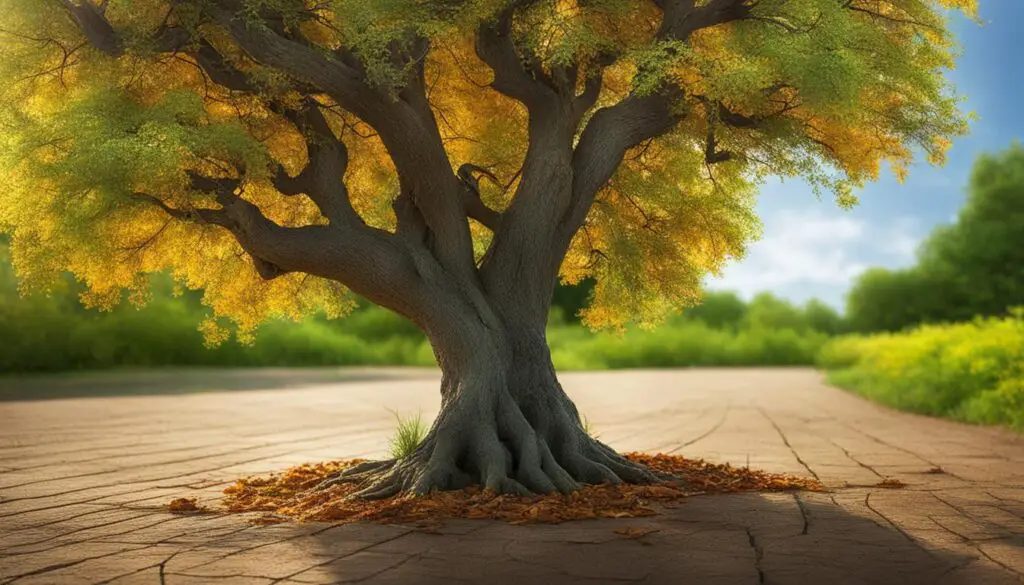Autumn is a season of dramatic transformations in the natural world, with one of the most fascinating phenomena being the shedding of leaves by deciduous trees. In this article, we will explore the science behind why leaves shed in autumn and uncover the biological, ecological, and evolutionary factors that drive this process.
Key Takeaways:
- Deciduous trees shed their leaves in autumn as a natural process influenced by various biological and environmental factors.
- Photosynthesis, the process by which trees convert sunlight, carbon dioxide, and water into glucose and oxygen, involves the crucial role of leaves.
- Environmental factors such as daylight hours, dropping temperatures, and resource allocation trigger the shedding of leaves in autumn.
- Leaf shedding, also known as abscission, is a controlled process involving hormonal changes, reduced nutrient transport, and the development of an abscission layer.
- The adaptive benefits of leaf shedding include water conservation, protection from cold, nutrient recycling, and energy savings.
Understanding Photosynthesis and the Role of Leaves
To understand why leaves fall off trees in autumn, we must first grasp the process of photosynthesis. Leaves play a crucial role in photosynthesis, which is the biochemical process that allows trees to convert sunlight, carbon dioxide, and water into glucose and oxygen. Chlorophyll, a green pigment, is essential for this process and gives leaves their green color. The vibrant colors seen in autumn are a result of chemical changes in the chlorophyll as it breaks down, revealing other pigments such as anthocyanins and carotenoids.
This image illustrates the intricate relationship between photosynthesis, leaves, and the vibrant autumn colors. It showcases the green chlorophyll pigment that is crucial for photosynthesis and how the breakdown of chlorophyll leads to the emergence of other pigments, creating the stunning shades of red, orange, and yellow that we associate with autumn leaves.
Environmental Factors That Trigger Leaf Shedding
In autumn, several environmental factors contribute to the shedding of leaves in trees. These factors are vital in initiating the natural process of leaf shedding, ensuring the survival of trees during the colder months.
One significant environmental factor is the reduction in daylight hours. As the days grow shorter, trees sense the diminishing light, which acts as a signal to initiate the shedding process. This photoperiodism response triggers trees to prepare for winter and shed their leaves.
Additionally, dropping temperatures play a crucial role in leaf shedding. As temperatures decrease, the effectiveness of photosynthesis diminishes, making it less efficient for trees to produce energy from sunlight, carbon dioxide, and water. In response, trees shed their leaves to conserve resources and redirect energy towards root systems and energy storage.
Resource allocation is another critical factor in leaf shedding. As autumn approaches, trees reallocate resources, concentrating on roots and energy storage. By shedding leaves, trees reduce resource consumption and ensure sufficient nutrient reserves for the winter months.
Furthermore, shedding leaves helps trees avoid potential damage caused by frost. When exposed to freezing temperatures, water inside the leaves can freeze, leading to cell damage. By shedding their leaves, trees minimize the risk of frost damage and protect themselves from the harsh winter conditions.
Lastly, leaf shedding is also an effective mechanism for trees to reduce water loss. Leaves play a significant role in transpiration, the process by which water evaporates from the surface of leaves. By shedding leaves, trees minimize water loss and conserve moisture, essential for their survival during drier winter months.

Note: The image above visually represents the importance of water conservation during the leaf shedding process.
The Process of Leaf Shedding
Leaf shedding, also known as abscission, is a controlled process involving several key events. As autumn approaches, trees undergo senescence, where they reabsorb nutrients from the leaves and prepare for winter dormancy.
The development of the abscission layer at the base of the leaf stem is a fascinating aspect of leaf shedding, as it gradually disconnects the leaf from the tree. This layer severs the links between the leaf and the tree, ensuring that valuable nutrients are retained by the tree.
Hormonal changes play a significant role in leaf shedding, triggering the process and coordinating the activities within the tree. These hormones regulate the development of the abscission layer and initiate the separation of the leaf from the tree.
Reduced nutrient transport is another crucial factor in leaf shedding. As the tree prepares for winter dormancy, it redirects resources away from the leaves and towards other parts of the plant, such as the roots. This reduction in nutrient supply accelerates the senescence process and aids in the detachment of the leaf.
Pigment changes also contribute to the eventual detachment of the leaf from the tree. As chlorophyll production decreases, other pigments in the leaf, such as carotenoids and anthocyanins, become more prominent, giving the leaves their vibrant autumn colors. These pigments play a role in protecting the leaf from stress and aiding in the efficient reabsorption of nutrients.
The culmination of these processes leads to the separation of the leaf from the abscission layer, resulting in leaf shedding. The detached leaves then fall to the ground, completing the natural cycle of nutrient recycling and preparing the tree for winter dormancy.
Key Events in Leaf Shedding
| Event | Description |
|---|---|
| Senescence | The reabsorption of nutrients from the leaves by the tree in preparation for winter. |
| Abscission Layer Development | The gradual formation of a layer at the base of the leaf stem that disconnects the leaf from the tree. |
| Hormonal Changes | The regulation of the leaf shedding process by specific hormones within the tree. |
| Reduced Nutrient Transport | The redirection of resources away from the leaves, accelerating the senescence process. |
| Pigment Changes | The shifts in pigment production, resulting in the vibrant autumn colors of the leaves. |
| Leaf Separation | The detachment of the leaf from the abscission layer, leading to leaf shedding. |
Adaptive Benefits of Leaf Shedding
Leaf shedding in autumn serves several important ecological and adaptive purposes. By shedding leaves, trees can conserve water during dry winter months and reduce the risk of damage from freezing temperatures. The fallen leaves also release valuable nutrients back into the soil, contributing to nutrient recycling. Shedding leaves conserves energy for the tree and prepares it for the following spring.
In addition to the aesthetic beauty of autumn foliage, leaf shedding plays a vital role in the survival and resilience of trees. It is a strategy that allows trees to adapt to changing environmental conditions and ensure their long-term sustainability.
One of the key benefits of leaf shedding is water conservation. During the winter months, water availability may become limited due to freezing temperatures and reduced precipitation. By shedding leaves, trees minimize water loss through transpiration, the process by which water evaporates from the leaves. This helps them conserve precious water resources, ensuring their survival through the dry winter season.
Another important adaptive advantage of leaf shedding is protection from cold. During winter, freezing temperatures can pose a significant threat to the viability of leaves. By shedding their leaves, trees reduce the risk of damage caused by frost and ice formation. Without leaves, trees are better able to withstand extreme cold and maintain their structural integrity.
The fallen leaves from deciduous trees also provide an ecological benefit through nutrient recycling. As leaves decompose on the forest floor, they gradually release nutrients back into the soil. These nutrients, such as nitrogen, phosphorus, and potassium, are essential for the healthy growth of plants. Nutrient recycling ensures that trees and other vegetation can access these vital elements when they start regrowing in the spring, promoting a sustainable ecosystem.

Finally, leaf shedding contributes to energy savings for trees. Withdrawing energy and nutrients from the leaves allows trees to divert resources to more critical functions during winter dormancy. By shedding their leaves, trees conserve energy that would otherwise be expended on leaf maintenance and growth. This energy is then redirected towards crucial processes such as root growth, energy storage, and preparing for the next growing season.
Overall, leaf shedding in autumn is a remarkable adaptation that enables trees to survive and thrive in challenging conditions. It offers benefits such as water conservation, protection from cold, nutrient recycling, and energy savings. Understanding the ecological significance of leaf shedding deepens our appreciation for the intricate processes that govern the natural world and reminds us of the remarkable adaptability of trees.
The Amazon Rainforest’s Seasonal Patterns
While most people associate the Amazon Rainforest with evergreen foliage, research has revealed fascinating seasonal patterns in leaf area. Studies have shown that the rainforest experiences a gradual increase in leaf area before the onset of the dry season, peaking a few months later. The majority of the rainforest exhibits a clear seasonal cycle, with greater leaf area during the dry season. This increase in leaf area is not solely due to sunlight but is also influenced by the anticipation of the light-rich dry season.
The Role of Chlorophyll, Carotenoids, and Anthocyanins
During the dry season, the Amazon Rainforest showcases vibrant colors, thanks to the presence of different pigments, including chlorophyll, carotenoids, and anthocyanins. Chlorophyll, responsible for the green color of leaves, undergoes chemical changes, leading to the breakdown of the pigment and the unveiling of other pigments. Carotenoids contribute to the yellow and orange hues, while anthocyanins create shades of red and purple.
Influence of Sunlight and Rainfall
The seasonal patterns of leaf area in the Amazon Rainforest are not solely determined by sunlight but also heavily influenced by rainfall. The timing and duration of rainfall have a significant impact on leaf growth and shedding. Rainfall provides the necessary moisture to support foliage growth, while sunlight fuels photosynthesis. The anticipation of abundant sunlight during the dry season drives the increase in leaf area.
Unmasking the True Colors of Autumn Leaves
In autumn, the chemistry of leaf color changes takes center stage. As chlorophyll production decreases, other pigments such as carotenoids and anthocyanins become more prominent, showcasing shades of yellow, orange, and red. These pigments complement chlorophyll and serve various functions in plants, including protection from light damage and nutrient absorption. As the pigments fade, tannins, waste products from plant metabolism, give leaves a brown color before they fall.

| Pigment | Color | Function |
|---|---|---|
| Chlorophyll | Green | Plays a key role in photosynthesis |
| Carotenoids | Yellow, orange | Protects leaves from excessive light |
| Anthocyanins | Red, purple | Helps with nutrient absorption |
| Tannins | Brown | Waste products of plant metabolism |
The Fall of Leaves: Preparation and Process
Trees undergo a meticulous preparation process before shedding their leaves. They create a protective barrier called the abscission layer at the base of each leaf stalk. This layer severs the links between the tree and its leaves, ensuring that the tree retains important nutrients.
Over time, the dying leaf becomes detached from the tree, facilitated by the abscission layer. This detachment is a gradual process driven by various factors such as hormonal changes, reduced nutrient transport, and pigment alterations in the leaves.
Eventually, when the bonds are sufficiently weakened and the conditions are right, the leaves gracefully fall to the ground. This leaf fall is an essential part of the tree’s preparation for the upcoming winter, allowing it to conserve resources and focus its energy on surviving the cold months ahead.
Conclusion
The annual shedding of leaves in autumn is a captivating phenomenon that holds many seasonal secrets. Trees have developed adaptive benefits to navigate the challenges of winter, ensuring their survival through the colder months. While the vibrant hues of autumn colors are visually stunning, the significance of leaf shedding reaches far beyond aesthetics.
One of the key benefits of leaf shedding is water conservation. By shedding leaves, trees can conserve precious water resources during the dry winter months, when water may be scarce. Additionally, the shedding of leaves protects trees from the cold. By reducing surface area, trees minimize the risk of frost damage, allowing them to better withstand freezing temperatures.
Moreover, leaf shedding plays a vital role in nutrient recycling. As leaves fall, they decompose, releasing essential nutrients back into the soil. This natural process replenishes the nutrient content, enriching the soil for future plant growth. Furthermore, shedding leaves also allows trees to conserve energy. By redirecting resources away from maintaining leaves, trees can save energy and allocate it towards other essential functions, such as root growth and energy storage.
The intricate processes underlying leaf shedding and the adaptive benefits it provides showcase the astonishing complexity of nature. Understanding why trees lose their leaves in autumn reveals the remarkable mechanisms that enable trees to thrive in ever-changing environments. As the vibrant autumn colors fade, we are reminded of the enduring resilience and sustainability of the natural world.
FAQ
Why do trees lose their leaves in autumn?
Trees shed their leaves in autumn as a response to environmental cues such as reduced daylight hours and dropping temperatures. This process, known as leaf shedding or abscission, helps trees conserve water, avoid frost damage, and prepare for winter dormancy.
What is the role of leaves in photosynthesis?
Leaves play a crucial role in photosynthesis, the biochemical process that enables trees to convert sunlight, carbon dioxide, and water into glucose and oxygen. Chlorophyll, a green pigment in leaves, captures sunlight and initiates the process of converting light energy into chemical energy.
What environmental factors trigger leaf shedding?
Leaf shedding in trees is triggered by a reduction in daylight hours, dropping temperatures, and the less efficient photosynthesis that comes with it. In preparation for winter, trees redirect resources to their roots and energy storage, prioritizing resource allocation and reducing water loss through transpiration.
What is the process of leaf shedding?
Leaf shedding, also known as abscission, is a controlled process involving several key events. As autumn approaches, trees undergo senescence, reabsorbing nutrients from their leaves and forming an abscission layer at the base of the leaf stem. This layer gradually disconnects the leaf from the tree, leading to its eventual detachment and fall.
What are the adaptive benefits of leaf shedding?
Leaf shedding in autumn serves several important ecological and adaptive purposes. It allows trees to conserve water during dry winter months, reduce the risk of damage from freezing temperatures, recycle nutrients by releasing them back into the soil, conserve energy, and prepare for the following spring.
Do deciduous trees in the Amazon Rainforest shed their leaves?
Yes, research has revealed seasonal patterns in leaf area in the Amazon Rainforest. While most people associate the rainforest with evergreen foliage, studies have shown that it experiences a gradual increase in leaf area before the dry season, peaking a few months later. The majority of the rainforest exhibits a clear seasonal cycle with greater leaf area during the dry season.
What causes the colors of autumn leaves?
The vibrant colors seen in autumn leaves are a result of chemical changes in the chlorophyll pigment as it breaks down. Other pigments, such as carotenoids and anthocyanins, become more prominent and showcase shades of yellow, orange, and red. As these pigments fade, tannins, waste products from plant metabolism, give leaves a brown color before they fall.
How do trees prepare for leaf shedding?
Trees prepare for leaf shedding by forming an abscission layer at the base of each leaf stalk. This layer creates a barrier between the dying leaf and the rest of the plant, allowing the tree to retain valuable nutrients. Eventually, the leaves detach and fall to the ground in preparation for winter.
What is the significance of the annual shedding of leaves in autumn?
The annual shedding of leaves in autumn is a remarkable display of nature’s adaptability and efficiency. It not only contributes to water conservation, protection from cold, nutrient recycling, and energy savings for the trees but also showcases the intricate biological and ecological processes that govern our world.

